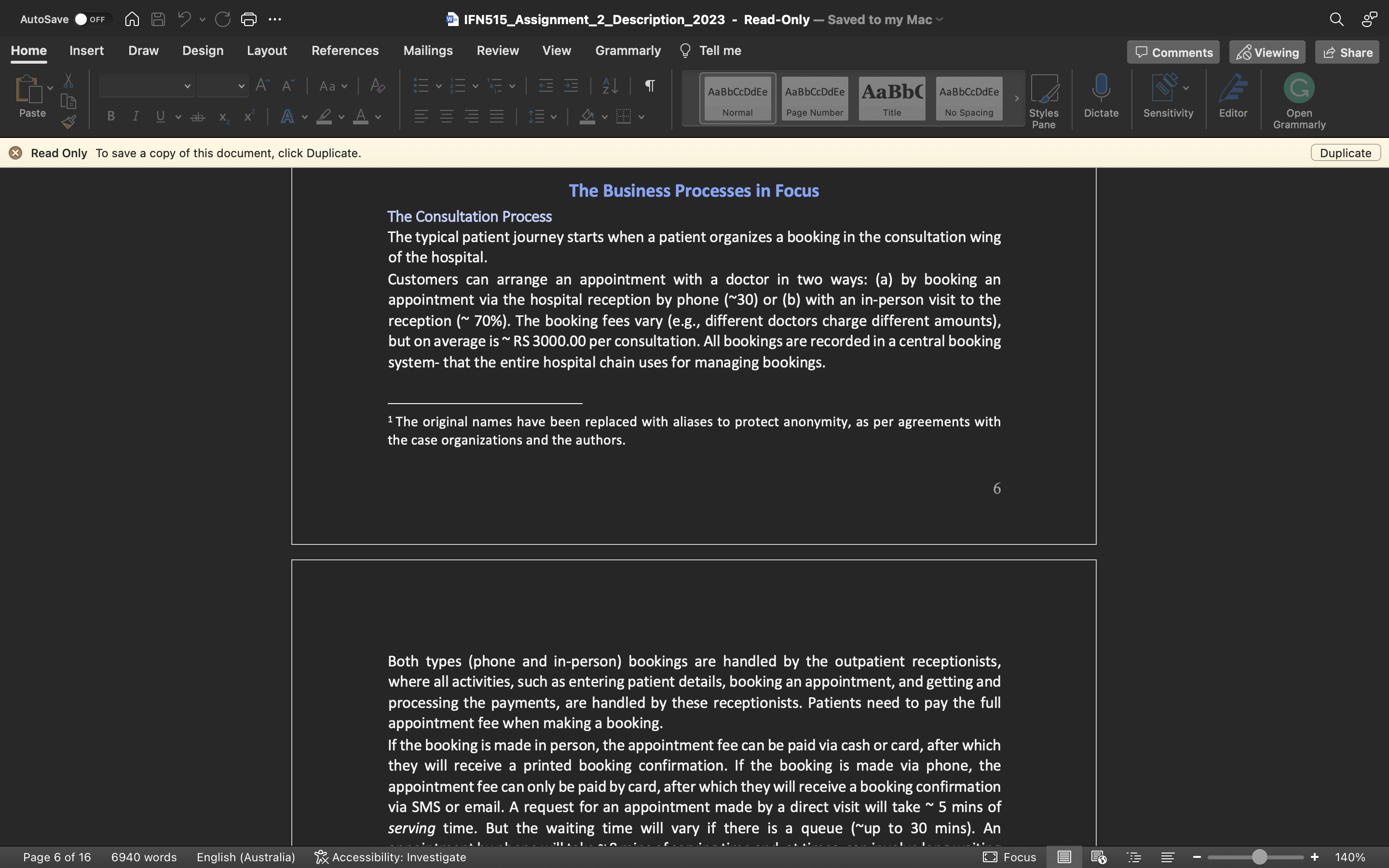
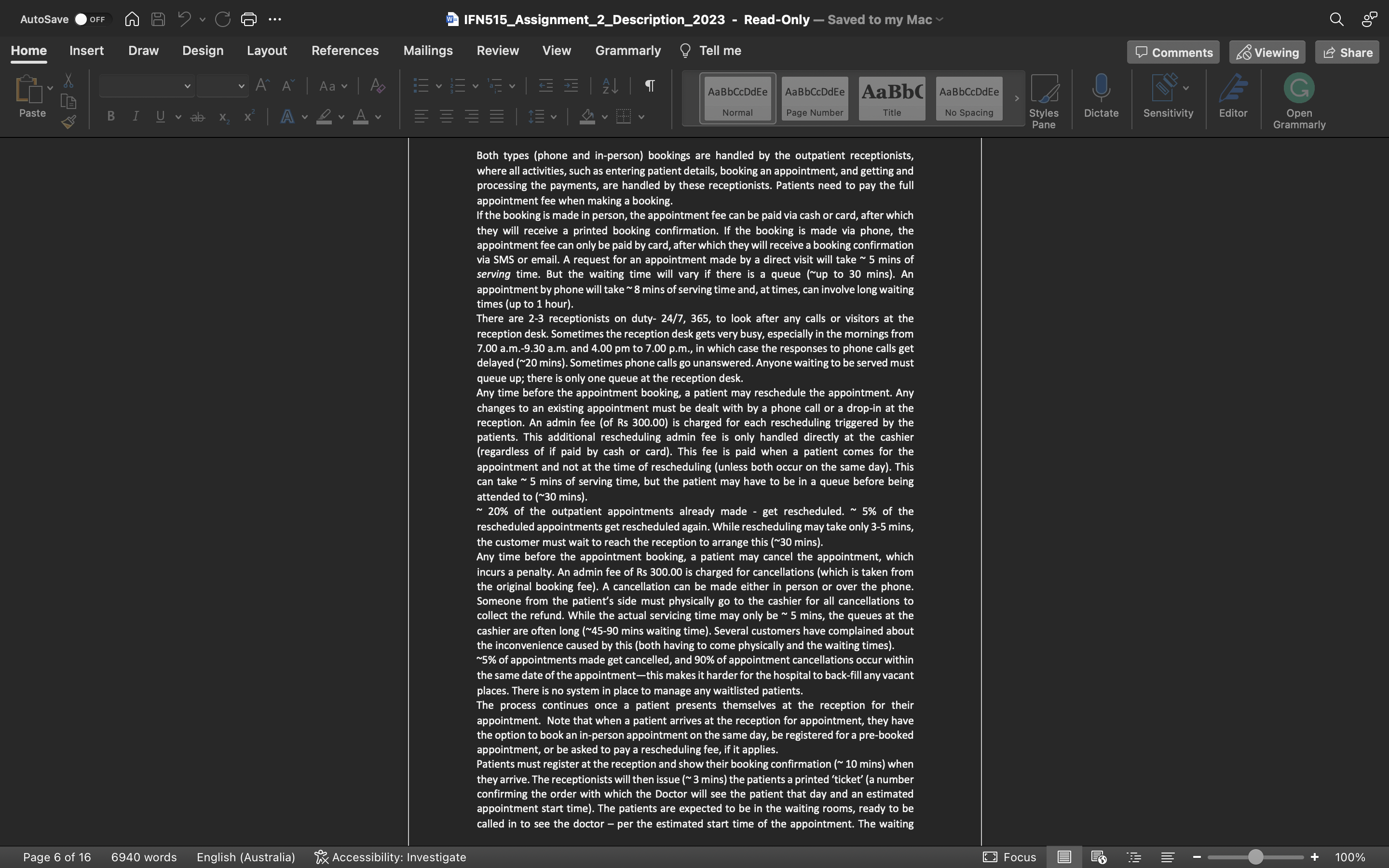
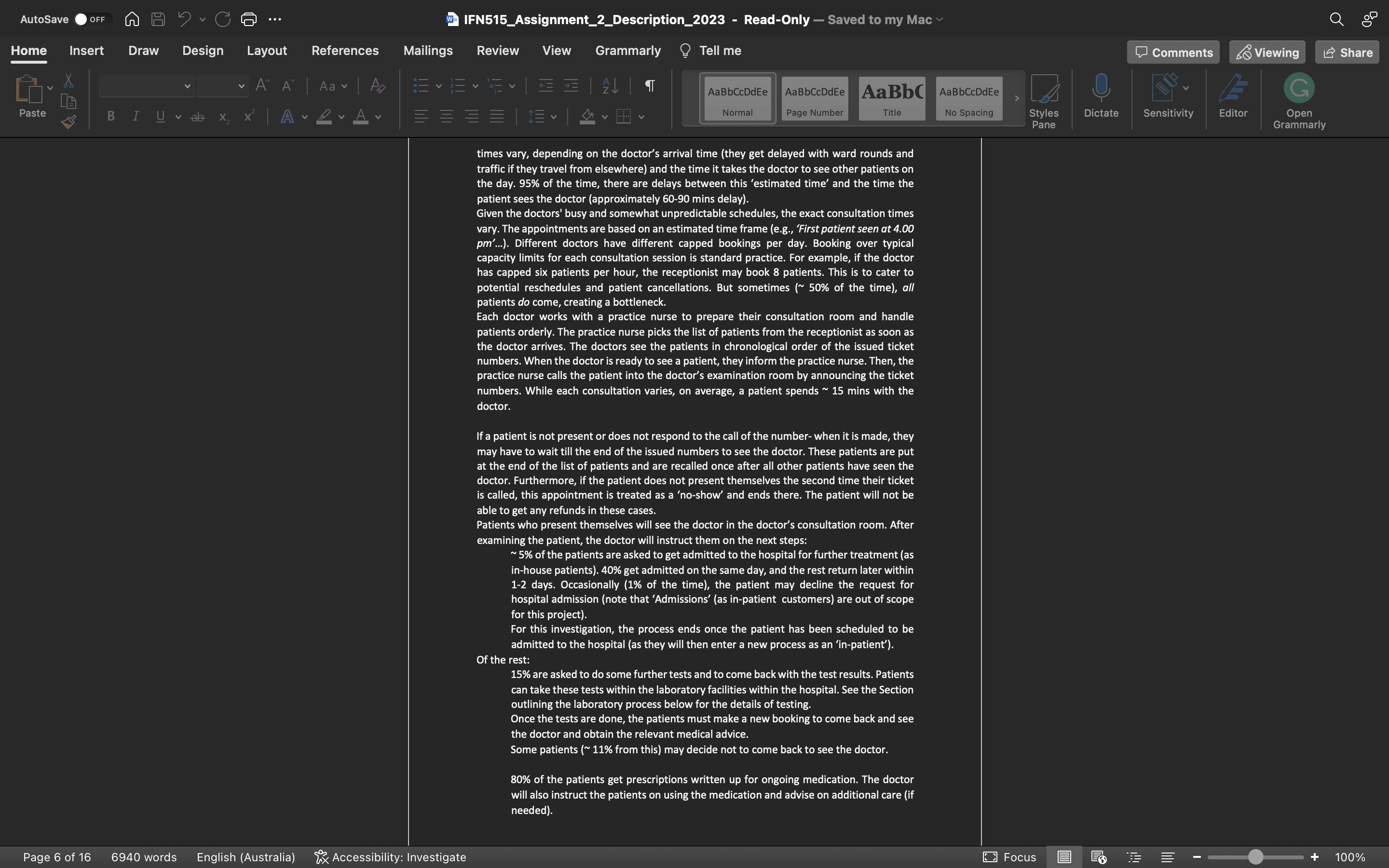
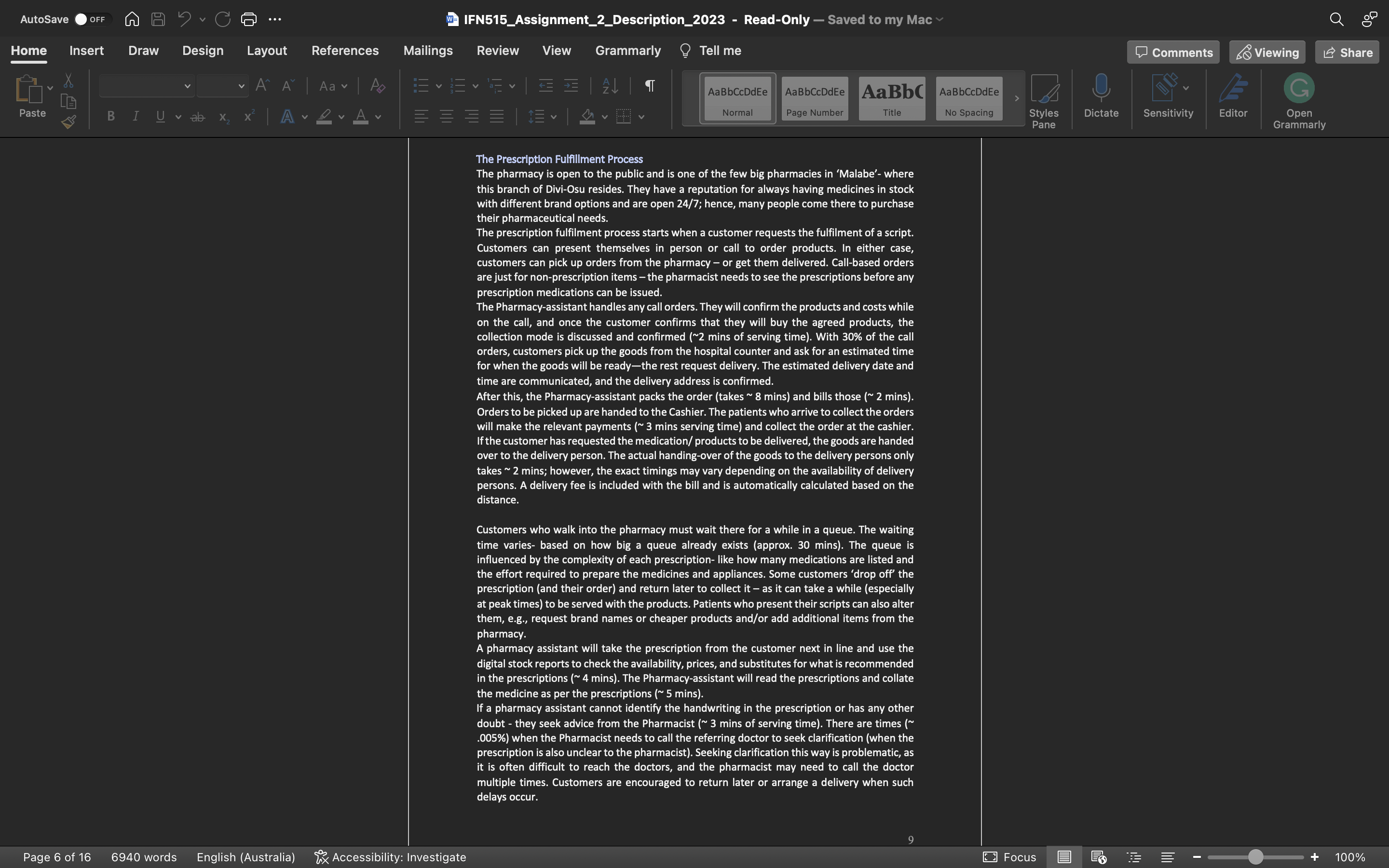
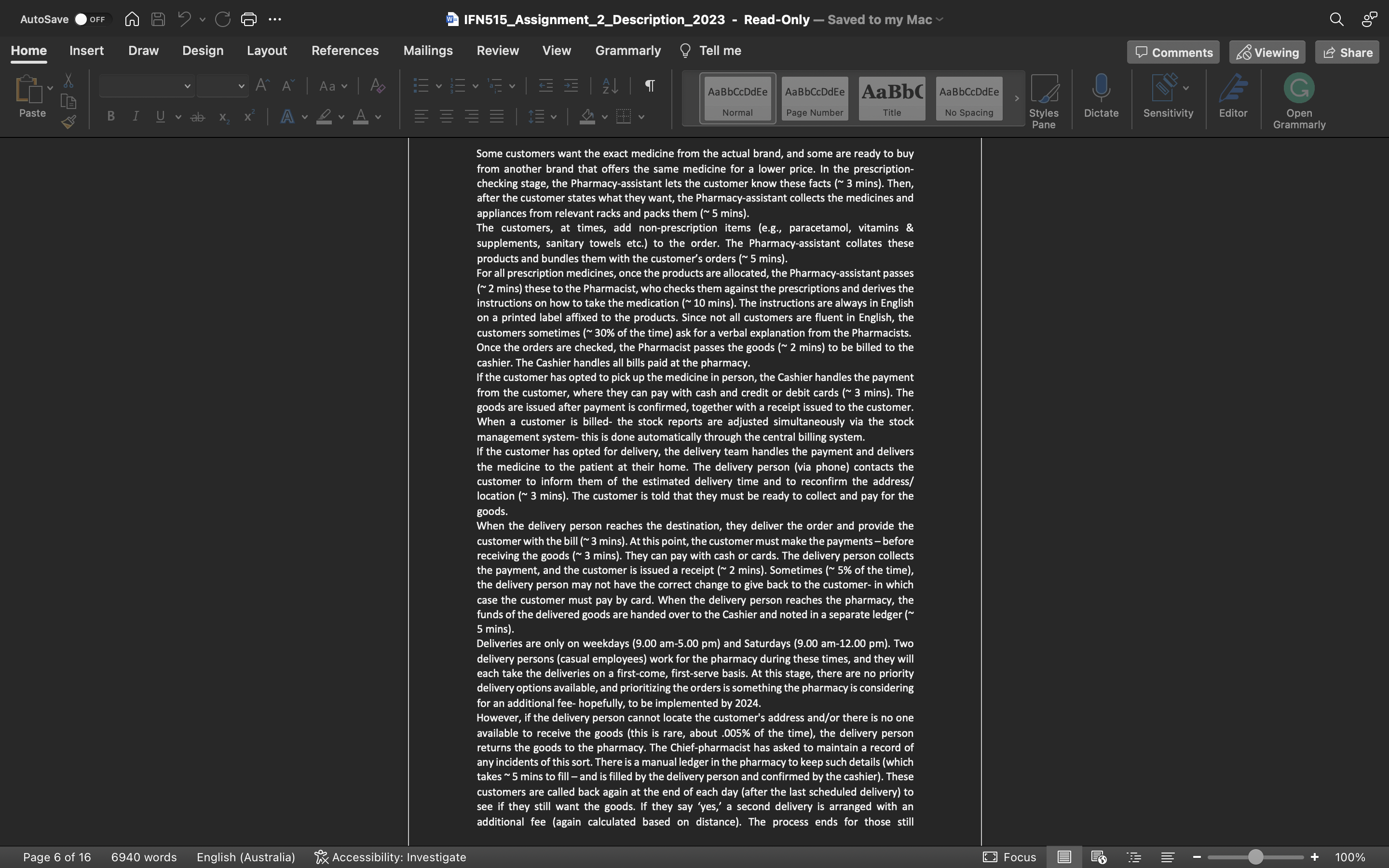
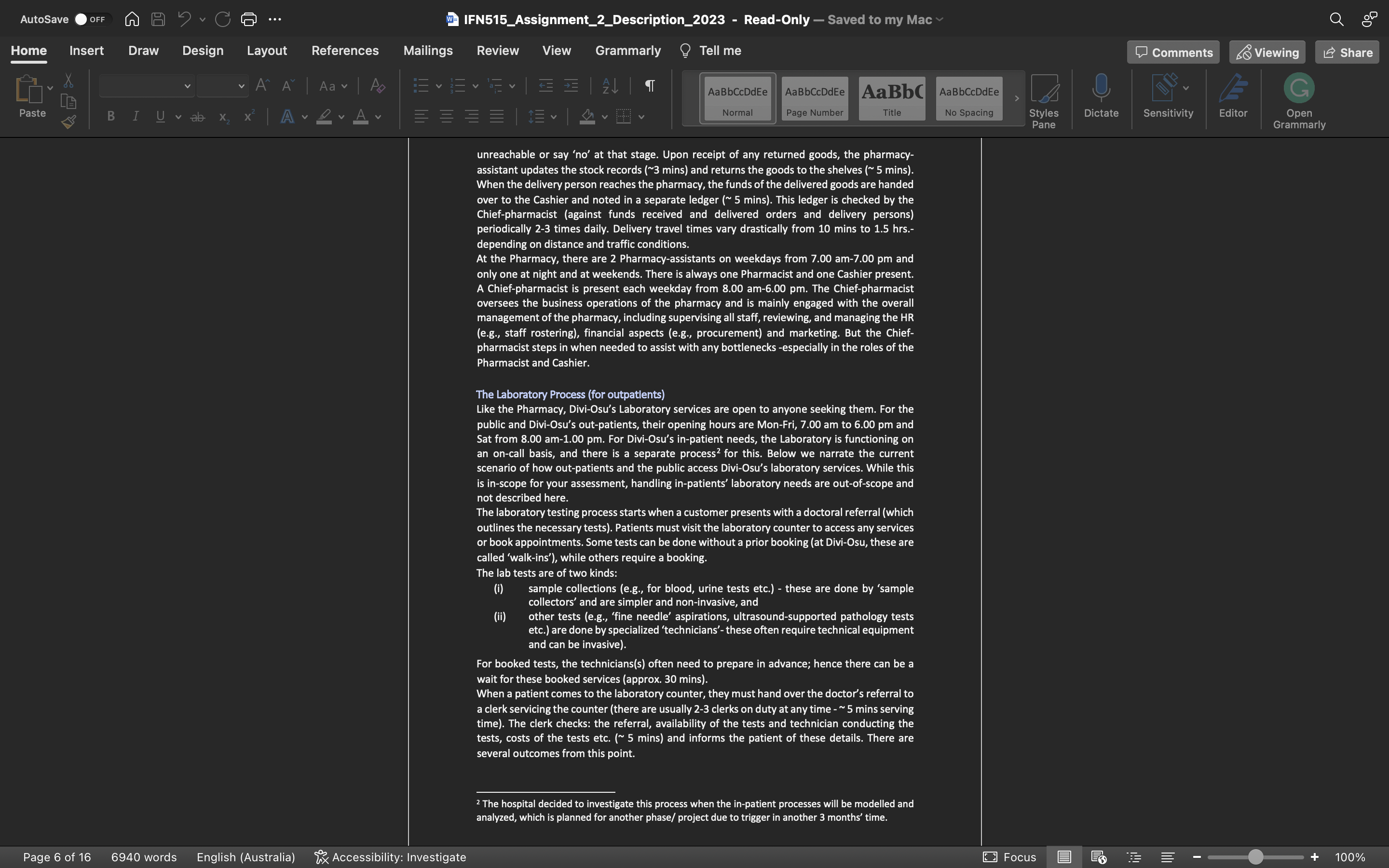
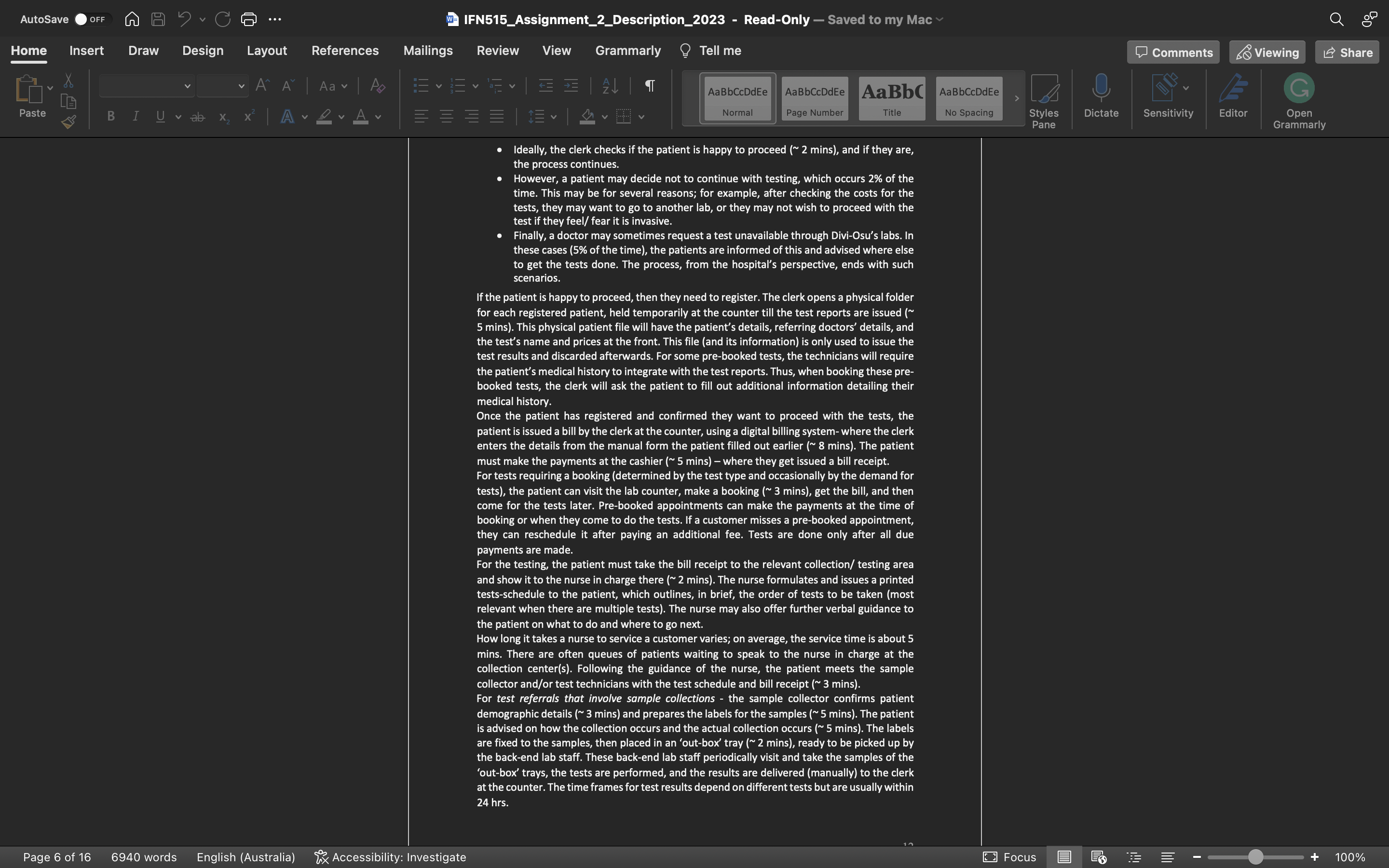
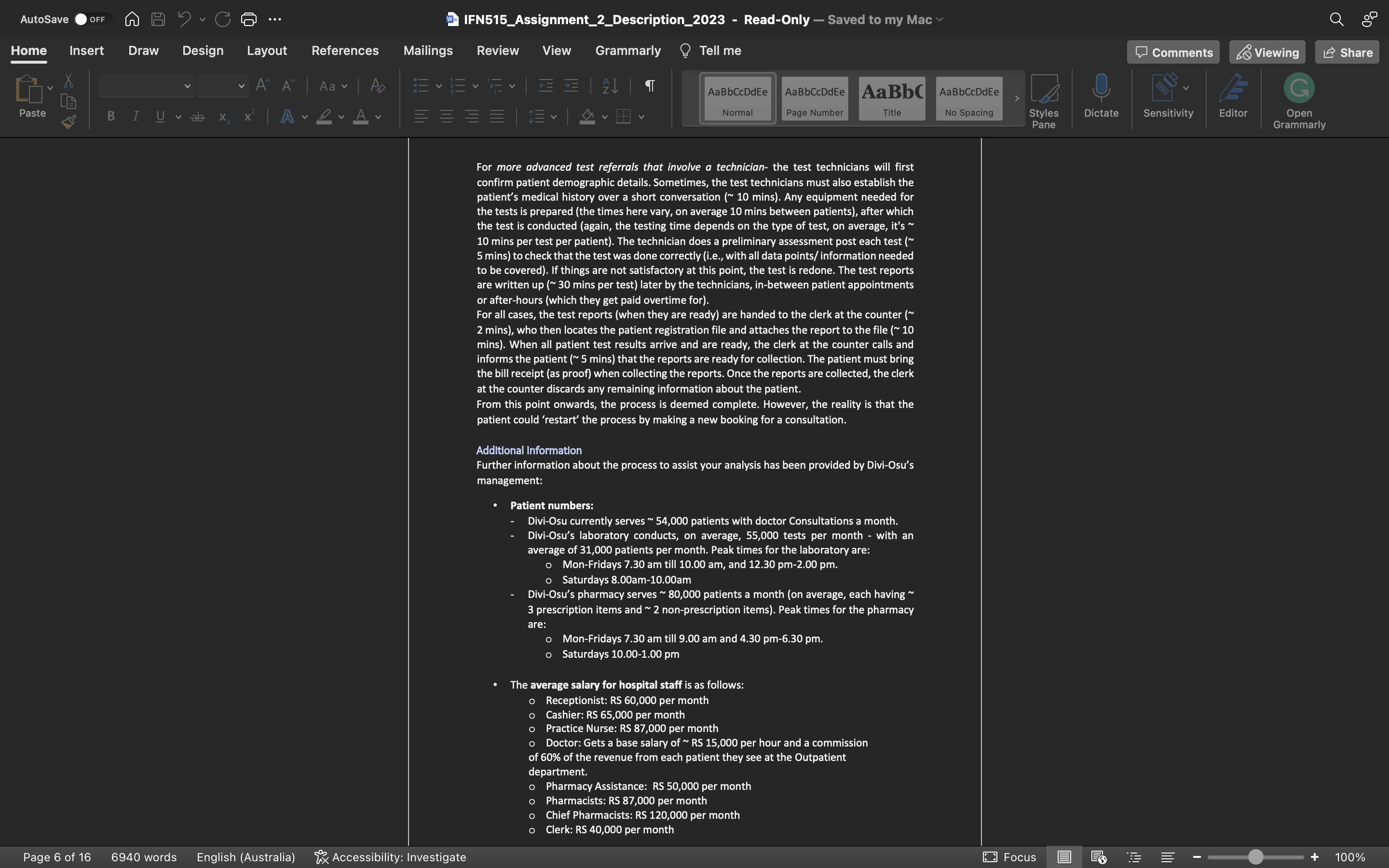
Task 1: Analysis of the current process. Specifically, the Divi-Osu management team is interested in:
- the identification and analysis of all process waste, using a variety of qualitative and quantitative techniques;
- the development of a comprehensive register of issues in the current process, including their root causes; and
- a discussion on their impact on the overall efficiency of the process.
Your findings should be supported by a detailed analysis through the application of appropriate analytical techniques.
Task 2: Improvement of the current process. Specifically, your consulting team is expected to identify a set of different process changes which can benefit the process, including:
- a variety of improvement ideas that focus on enhancement techniques
- at least one improvement idea (for part/all of the process) which has been derived from existing practice.
- at least one improvement idea (for part/all of the process) which exploits an existing resource that is currently underutilized.
For each new idea presented, you are expected to:
- Classify the idea as being achievable in the short term (next 3-6 months) or in the long term (next 1-3 years).
- Explain the qualitative and quantitative benefits of the idea, when implemented.
- Assess the feasibility of your improvement recommendation.
Read Only To save a copy of this document, click Duplicate. The Business Processes in Focus The Consultation Process The typical patient journey starts when a patient organizes a booking in the consultation wing of the hospital. Customers can arrange an appointment with a doctor in two ways: (a) by booking an appointment via the hospital reception by phone ( 30 ) or (b) with an in-person visit to the reception ( 70\%). The booking fees vary (e.g., different doctors charge different amounts), but on average is RS3000.00 per consultation. All bookings are recorded in a central booking system- that the entire hospital chain uses for managing bookings. 1 The original names have been replaced with aliases to protect anonymity, as per agreements with the case organizations and the authors. 6 Both types (phone and in-person) bookings are handled by the outpatient receptionists, where all activities, such as entering patient details, booking an appointment, and getting and processing the payments, are handled by these receptionists. Patients need to pay the full appointment fee when making a booking. If the booking is made in person, the appointment fee can be paid via cash or card, after which they will receive a printed booking confirmation. If the booking is made via phone, the appointment fee can only be paid by card, after which they will receive a booking confirmation via SMS or email. A request for an appointment made by a direct visit will take 5 mins of serving time. But the waiting time will vary if there is a queue ( up to 30mins ). An The Prescription Fulfillment Process The pharmacy is open to the public and is one of the few big pharmacies in 'Malabe'- where this branch of Divi-Osu resides. They have a reputation for always having medicines in stock with different brand options and are open 24/7; hence, many people come there to purchase their pharmaceutical needs. The prescription fulfilment process starts when a customer requests the fulfilment of a script. Customers can present themselves in person or call to order products. In either case, customers can pick up orders from the pharmacy - or get them delivered. Call-based orders are just for non-prescription items - the pharmacist needs to see the prescriptions before any prescription medications can be issued. The Pharmacy-assistant handles any call orders. They will confirm the products and costs while on the call, and once the customer confirms that they will buy the agreed products, the collection mode is discussed and confirmed ( 2 mins of serving time). With 30% of the call orders, customers pick up the goods from the hospital counter and ask for an estimated time for when the goods will be ready-the rest request delivery. The estimated delivery date and time are communicated, and the delivery address is confirmed. After this, the Pharmacy-assistant packs the order (takes 8 mins) and bills those ( 2 mins). Orders to be picked up are handed to the Cashier. The patients who arrive to collect the orders will make the relevant payments ( 3 mins serving time) and collect the order at the cashier. If the customer has requested the medication/ products to be delivered, the goods are handed over to the delivery person. The actual handing-over of the goods to the delivery persons only takes 2 mins; however, the exact timings may vary depending on the availability of delivery persons. A delivery fee is included with the bill and is automatically calculated based on the distance. Customers who walk into the pharmacy must wait there for a while in a queue. The waiting time varies- based on how big a queue already exists (approx. 30 mins). The queue is influenced by the complexity of each prescription- like how many medications are listed and the effort required to prepare the medicines and appliances. Some customers 'drop off' the prescription (and their order) and return later to collect it - as it can take a while (especially at peak times) to be served with the products. Patients who present their scripts can also alter them, e.g., request brand names or cheaper products and/or add additional items from the pharmacy. A pharmacy assistant will take the prescription from the customer next in line and use the digital stock reports to check the availability, prices, and substitutes for what is recommended in the prescriptions ( 4 mins). The Pharmacy-assistant will read the prescriptions and collate the medicine as per the prescriptions ( 5 mins). If a pharmacy assistant cannot identify the handwriting in the prescription or has any other doubt - they seek advice from the Pharmacist ( 3 mins of serving time). There are times ( .005% ) when the Pharmacist needs to call the referring doctor to seek clarification (when the prescription is also unclear to the pharmacist). Seeking clarification this way is problematic, as it is often difficult to reach the doctors, and the pharmacist may need to call the doctor multiple times. Customers are encouraged to return later or arrange a delivery when such delays occur. For more advanced test referrals that involve a technician- the test technicians will first confirm patient demographic details. Sometimes, the test technicians must also establish the patient's medical history over a short conversation ( 10 mins). Any equipment needed for the tests is prepared (the times here vary, on average 10 mins between patients), after which the test is conducted (again, the testing time depends on the type of test, on average, it's 10 mins per test per patient). The technician does a preliminary assessment post each test ( 5mins ) to check that the test was done correctly (i.e., with all data points/ information needed to be covered). If things are not satisfactory at this point, the test is redone. The test reports are written up ( 30 mins per test) later by the technicians, in-between patient appointments or after-hours (which they get paid overtime for). For all cases, the test reports (when they are ready) are handed to the clerk at the counter ( 2 mins), who then locates the patient registration file and attaches the report to the file ( 10 mins). When all patient test results arrive and are ready, the clerk at the counter calls and informs the patient ( 5 mins) that the reports are ready for collection. The patient must bring the bill receipt (as proof) when collecting the reports. Once the reports are collected, the clerk at the counter discards any remaining information about the patient. From this point onwards, the process is deemed complete. However, the reality is that the patient could 'restart' the process by making a new booking for a consultation. Additional Information Further information about the process to assist your analysis has been provided by Divi-Osu's management: - Patient numbers: - Divi-Osu currently serves 54,000 patients with doctor Consultations a month. - Divi-Osu's laboratory conducts, on average, 55,000 tests per month - with an average of 31,000 patients per month. Peak times for the laboratory are: Mon-Fridays 7.30am till 10.00am, and 12.30pm2.00pm. Saturdays 8.00am-10.00am - Divi-Osu's pharmacy serves 80,000 patients a month (on average, each having 3 prescription items and 2 non-prescription items). Peak times for the pharmacy are: Mon-Fridays 7.30am till 9.00am and 4.30pm6.30pm. Saturdays 10.001.00pm - The average salary for hospital staff is as follows: Receptionist: RS 60,000 per month Cashier: RS 65,000 per month - Practice Nurse: RS 87,000 per month Doctor: Gets a base salary of RS 15,000 per hour and a commission of 60% of the revenue from each patient they see at the Outpatient department. Pharmacy Assistance: RS 50,000 per month Pharmacists: RS 87,000 per month Chief Pharmacists: RS 120,000 per month Clerk: RS 40,000 per month - Ideally, the clerk checks if the patient is happy to proceed ( 2 mins), and if they are, the process continues. - However, a patient may decide not to continue with testing, which occurs 2% of the time. This may be for several reasons; for example, after checking the costs for the tests, they may want to go to another lab, or they may not wish to proceed with the test if they feel/ fear it is invasive. - Finally, a doctor may sometimes request a test unavailable through Divi-Osu's labs. In these cases ( 5% of the time), the patients are informed of this and advised where else to get the tests done. The process, from the hospital's perspective, ends with such scenarios. If the patient is happy to proceed, then they need to register. The clerk opens a physical folder for each registered patient, held temporarily at the counter till the test reports are issued ( 5 mins). This physical patient file will have the patient's details, referring doctors' details, and the test's name and prices at the front. This file (and its information) is only used to issue the test results and discarded afterwards. For some pre-booked tests, the technicians will require the patient's medical history to integrate with the test reports. Thus, when booking these prebooked tests, the clerk will ask the patient to fill out additional information detailing their medical history. Once the patient has registered and confirmed they want to proceed with the tests, the patient is issued a bill by the clerk at the counter, using a digital billing system- where the clerk enters the details from the manual form the patient filled out earlier ( 8 mins). The patient must make the payments at the cashier ( 5 mins) - where they get issued a bill receipt. For tests requiring a booking (determined by the test type and occasionally by the demand for tests), the patient can visit the lab counter, make a booking ( 3 mins), get the bill, and then come for the tests later. Pre-booked appointments can make the payments at the time of booking or when they come to do the tests. If a customer misses a pre-booked appointment, they can reschedule it after paying an additional fee. Tests are done only after all due payments are made. For the testing, the patient must take the bill receipt to the relevant collection/ testing area and show it to the nurse in charge there ( 2 mins). The nurse formulates and issues a printed tests-schedule to the patient, which outlines, in brief, the order of tests to be taken (most relevant when there are multiple tests). The nurse may also offer further verbal guidance to the patient on what to do and where to go next. How long it takes a nurse to service a customer varies; on average, the service time is about 5 mins. There are often queues of patients waiting to speak to the nurse in charge at the collection center(s). Following the guidance of the nurse, the patient meets the sample collector and/or test technicians with the test schedule and bill receipt ( 3 mins). For test referrals that involve sample collections - the sample collector confirms patient demographic details ( 3 mins) and prepares the labels for the samples ( 5 mins). The patient is advised on how the collection occurs and the actual collection occurs ( 5 mins). The labels are fixed to the samples, then placed in an 'out-box' tray ( 2 mins), ready to be picked up by the back-end lab staff. These back-end lab staff periodically visit and take the samples of the 'out-box' trays, the tests are performed, and the results are delivered (manually) to the clerk at the counter. The time frames for test results depend on different tests but are usually within 24 hrs. unreachable or say 'no' at that stage. Upon receipt of any returned goods, the pharmacyassistant updates the stock records ( 3 mins) and returns the goods to the shelves ( 5 mins). When the delivery person reaches the pharmacy, the funds of the delivered goods are handed over to the Cashier and noted in a separate ledger ( 5 mins). This ledger is checked by the Chief-pharmacist (against funds received and delivered orders and delivery persons) periodically 2-3 times daily. Delivery travel times vary drastically from 10 mins to 1.5 hrs.depending on distance and traffic conditions. At the Pharmacy, there are 2 Pharmacy-assistants on weekdays from 7.00am7.00pm and only one at night and at weekends. There is always one Pharmacist and one Cashier present. A Chief-pharmacist is present each weekday from 8.00 am-6.00 pm. The Chief-pharmacist oversees the business operations of the pharmacy and is mainly engaged with the overall management of the pharmacy, including supervising all staff, reviewing, and managing the HR (e.g., staff rostering), financial aspects (e.g., procurement) and marketing. But the Chiefpharmacist steps in when needed to assist with any bottlenecks -especially in the roles of the Pharmacist and Cashier. The Laboratory Process (for outpatients) Like the Pharmacy, Divi-Osu's Laboratory services are open to anyone seeking them. For the public and Divi-Osu's out-patients, their opening hours are Mon-Fri, 7.00 am to 6.00pm and Sat from 8.00 am-1.00 pm. For Divi-Osu's in-patient needs, the Laboratory is functioning on an on-call basis, and there is a separate process 2 for this. Below we narrate the current scenario of how out-patients and the public access Divi-Osu's laboratory services. While this is in-scope for your assessment, handling in-patients' laboratory needs are out-of-scope and not described here. The laboratory testing process starts when a customer presents with a doctoral referral (which outlines the necessary tests). Patients must visit the laboratory counter to access any services or book appointments. Some tests can be done without a prior booking (at Divi-Osu, these are called 'walk-ins'), while others require a booking. The lab tests are of two kinds: (i) sample collections (e.g., for blood, urine tests etc.) - these are done by 'sample collectors' and are simpler and non-invasive, and (ii) other tests (e.g., 'fine needle' aspirations, ultrasound-supported pathology tests etc.) are done by specialized 'technicians' - these often require technical equipment and can be invasive). For booked tests, the technicians(s) often need to prepare in advance; hence there can be a wait for these booked services (approx. 30 mins). When a patient comes to the laboratory counter, they must hand over the doctor's referral to a clerk servicing the counter (there are usually 2-3 clerks on duty at any time - 5 mins serving time). The clerk checks: the referral, availability of the tests and technician conducting the tests, costs of the tests etc. ( 5 mins) and informs the patient of these details. There are several outcomes from this point. 2 The hospital decided to investigate this process when the in-patient processes will be modelled and analyzed, which is planned for another phase/ project due to trigger in another 3 months' time. times vary, depending on the doctor's arrival time (they get delayed with ward rounds and traffic if they travel from elsewhere) and the time it takes the doctor to see other patients on the day. 95% of the time, there are delays between this 'estimated time' and the time the patient sees the doctor (approximately 60-90 mins delay). Given the doctors' busy and somewhat unpredictable schedules, the exact consultation times vary. The appointments are based on an estimated time frame (e.g., 'First patient seen at 4.00 pm...). Different doctors have different capped bookings per day. Booking over typical capacity limits for each consultation session is standard practice. For example, if the doctor has capped six patients per hour, the receptionist may book 8 patients. This is to cater to potential reschedules and patient cancellations. But sometimes ( 50\% of the time), all patients do come, creating a bottleneck. Each doctor works with a practice nurse to prepare their consultation room and handle patients orderly. The practice nurse picks the list of patients from the receptionist as soon as the doctor arrives. The doctors see the patients in chronological order of the issued ticket numbers. When the doctor is ready to see a patient, they inform the practice nurse. Then, the practice nurse calls the patient into the doctor's examination room by announcing the ticket numbers. While each consultation varies, on average, a patient spends 15 mins with the doctor. If a patient is not present or does not respond to the call of the number- when it is made, they may have to wait till the end of the issued numbers to see the doctor. These patients are put at the end of the list of patients and are recalled once after all other patients have seen the doctor. Furthermore, if the patient does not present themselves the second time their ticket is called, this appointment is treated as a 'no-show' and ends there. The patient will not be able to get any refunds in these cases. Patients who present themselves will see the doctor in the doctor's consultation room. After examining the patient, the doctor will instruct them on the next steps: 5% of the patients are asked to get admitted to the hospital for further treatment (as in-house patients). 40% get admitted on the same day, and the rest return later within 1-2 days. Occasionally ( 1% of the time), the patient may decline the request for hospital admission (note that 'Admissions' (as in-patient customers) are out of scope for this project). For this investigation, the process ends once the patient has been scheduled to be admitted to the hospital (as they will then enter a new process as an 'in-patient'). Of the rest: 15% are asked to do some further tests and to come back with the test results. Patients can take these tests within the laboratory facilities within the hospital. See the Section outlining the laboratory process below for the details of testing. Once the tests are done, the patients must make a new booking to come back and see the doctor and obtain the relevant medical advice. Some patients ( 11\% from this) may decide not to come back to see the doctor. 80% of the patients get prescriptions written up for ongoing medication. The doctor will also instruct the patients on using the medication and advise on additional care (if needed). Both types (phone and in-person) bookings are handled by the outpatient receptionists, where all activities, such as entering patient details, booking an appointment, and getting and processing the payments, are handled by these receptionists. Patients need to pay the full appointment fee when making a booking. If the booking is made in person, the appointment fee can be paid via cash or card, after which they will receive a printed booking confirmation. If the booking is made via phone, the appointment fee can only be paid by card, after which they will receive a booking confirmation via SMS or email. A request for an appointment made by a direct visit will take 5 mins of appointment by phone will take 8 mins of serving time and, at times, can involve long waiting times (up to 1 hour). There are 23 receptionists on duty- 24/7,365, to look after any calls or visitors at the reception desk. Sometimes the reception desk gets very busy, especially in the mornings from 7.00 a.m. -9.30 a.m. and 4.00 pm to 7.00 p.m., in which case the responses to phone calls get delayed ( 20 mins). Sometimes phone calls go unanswered. Anyone waiting to be served must queue up; there is only one queue at the reception desk. Any time before the appointment booking, a patient may reschedule the appointment. Any changes to an existing appointment must be dealt with by a phone call or a drop-in at the reception. An admin fee (of Rs 300.00) is charged for each rescheduling triggered by the patients. This additional rescheduling admin fee is only handled directly at the cashier (regardless of if paid by cash or card). This fee is paid when a patient comes for the appointment and not at the time of rescheduling (unless both occur on the same day). This can take 5 mins of serving time, but the patient may have to be in a queue before being attended to ( 30 mins). 20% of the outpatient appointments already made - get rescheduled. 5% of the rescheduled appointments get rescheduled again. While rescheduling may take only 3-5 mins, the customer must wait to reach the reception to arrange this ( 30 mins). Any time before the appointment booking, a patient may cancel the appointment, which incurs a penalty. An admin fee of Rs 300.00 is charged for cancellations (which is taken from the original booking fee). A cancellation can be made either in person or over the phone. Someone from the patient's side must physically go to the cashier for all cancellations to collect the refund. While the actual servicing time may only be 5 mins, the queues at the cashier are often long ( 4590 mins waiting time). Several customers have complained about the inconvenience caused by this (both having to come physically and the waiting times). 5% of appointments made get cancelled, and 90% of appointment cancellations occur within the same date of the appointment-this makes it harder for the hospital to back-fill any vacant places. There is no system in place to manage any waitlisted patients. The process continues once a patient presents themselves at the reception for their appointment. Note that when a patient arrives at the reception for appointment, they have the option to book an in-person appointment on the same day, be registered for a pre-booked appointment, or be asked to pay a rescheduling fee, if it applies. Patients must register at the reception and show their booking confirmation ( 10 mins) when they arrive. The receptionists will then issue ( 3 mins) the patients a printed 'ticket' (a number confirming the order with which the Doctor will see the patient that day and an estimated appointment start time). The patients are expected to be in the waiting rooms, ready to be called in to see the doctor - per the estimated start time of the appointment. The waiting Some customers want the exact medicine from the actual brand, and some are ready to buy from another brand that offers the same medicine for a lower price. In the prescriptionchecking stage, the Pharmacy-assistant lets the customer know these facts ( 3 mins). Then, after the customer states what they want, the Pharmacy-assistant collects the medicines and appliances from relevant racks and packs them ( 5 mins). The customers, at times, add non-prescription items (e.g., paracetamol, vitamins \& supplements, sanitary towels etc.) to the order. The Pharmacy-assistant collates these products and bundles them with the customer's orders ( 5 mins). For all prescription medicines, once the products are allocated, the Pharmacy-assistant passes ( 2 mins) these to the Pharmacist, who checks them against the prescriptions and derives the instructions on how to take the medication ( 10 mins). The instructions are always in English on a printed label affixed to the products. Since not all customers are fluent in English, the customers sometimes ( 30\% of the time) ask for a verbal explanation from the Pharmacists. Once the orders are checked, the Pharmacist passes the goods ( 2 mins) to be billed to the cashier. The Cashier handles all bills paid at the pharmacy. If the customer has opted to pick up the medicine in person, the Cashier handles the payment from the customer, where they can pay with cash and credit or debit cards ( 3 mins). The goods are issued after payment is confirmed, together with a receipt issued to the customer. When a customer is billed- the stock reports are adjusted simultaneously via the stock management system- this is done automatically through the central billing system. If the customer has opted for delivery, the delivery team handles the payment and delivers the medicine to the patient at their home. The delivery person (via phone) contacts the customer to inform them of the estimated delivery time and to reconfirm the address/ location ( 3 mins). The customer is told that they must be ready to collect and pay for the goods. When the delivery person reaches the destination, they deliver the order and provide the customer with the bill ( 3 mins). At this point, the customer must make the payments - before receiving the goods ( 3 mins). They can pay with cash or cards. The delivery person collects the payment, and the customer is issued a receipt ( 2 mins). Sometimes ( 5\% of the time), the delivery person may not have the correct change to give back to the customer- in which case the customer must pay by card. When the delivery person reaches the pharmacy, the funds of the delivered goods are handed over to the Cashier and noted in a separate ledger ( 5 mins). Deliveries are only on weekdays (9.00 am-5.00 pm) and Saturdays (9.00 am-12.00 pm). Two delivery persons (casual employees) work for the pharmacy during these times, and they will each take the deliveries on a first-come, first-serve basis. At this stage, there are no priority delivery options available, and prioritizing the orders is something the pharmacy is considering for an additional fee- hopefully, to be implemented by 2024. However, if the delivery person cannot locate the customer's address and/or there is no one available to receive the goods (this is rare, about .005% of the time), the delivery person returns the goods to the pharmacy. The Chief-pharmacist has asked to maintain a record of any incidents of this sort. There is a manual ledger in the pharmacy to keep such details (which takes 5 mins to fill - and is filled by the delivery person and confirmed by the cashier). These customers are called back again at the end of each day (after the last scheduled delivery) to see if they still want the goods. If they say 'yes,' a second delivery is arranged with an additional fee (again calculated based on distance). The process ends for those still














